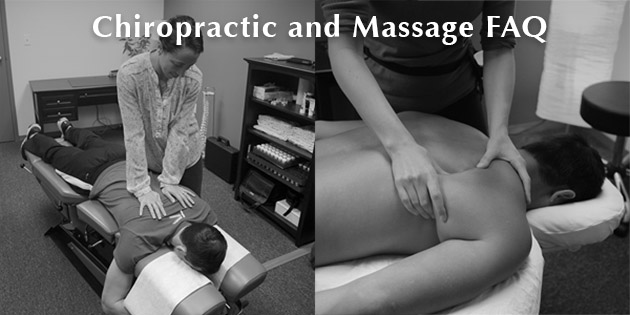 How are chiropractic and massage therapy similar?
How are chiropractic and massage therapy similar?
The fields of chiropractic and massage therapy share a lot in common both in philosophy and in practice. Both are natural, hands-on therapies that work to promote the body’s innate ability to heal itself. Both fall under the category of “conservative care,” meaning they pose a more moderate (or less risky) option than drugs or surgeries. Chiropractic and massage can also be used in conjunction with more aggressive medical care when necessary. Both chiropractic and massage therapy treat physical ailments related to acute trauma (car accidents, athletic injuries, surgeries), chronic conditions (arthritis, fibromyalgia), and persistent postural stresses (desk work, driving). Chiropractic and massage can also be used as part of an overall health and wellness program, to maintain strong defenses and prevent problems from creeping up. Both disciplines offer benefits including improved mobility and range of motion, better posture, and reduced pain and discomfort.
What is the difference between chiropractic and massage therapy?
Massage therapists are a licensed profession in Massachusetts and are required to meet some of the most extensive educational standards in the country. They administer manual treatment to the soft tissues of the body using a variety of techniques. They are trained to use oils and lotions, and to apply warm and cool therapies. Under the direction of a Doctor of Chiropractic, they can also help patients to implement appropriate stretching and strengthening programs to meet their recovery needs.
Chiropractors are physicians who have completed a four-year post-graduate doctoral program, and must be certified by both national and state boards. Doctors of Chiropractic conduct thorough medical histories and exams, order x-rays and other tests, make medical diagnoses, and set treatment plans. Treatment plans consider the big-picture, and may encompass ergonomic recommendations, nutritional changes or supplements, exercise regimens, and referrals to other practitioners. The chiropractic profession specializes in the skeletal and nervous systems, though doctors can often help patients to improve their function in other systems of the body as well by improving their structure. As part of addressing a patient’s structure, chiropractors must also evaluate and treat the muscles and soft tissues that attach to and move the bones. A Licensed Massage Therapist (LMT), however, can usually spend more time focused on soft tissue concerns than the Doctor of Chiropractic (DC) can.
How do I choose which treatment is right for me?
This is a bit of a trick question, because chiropractic and massage therapy are most effective when used together! We live in a society obsessed with the “quick fix”: an antacid for heartburn, an aspirin for a headache, a chiropractic adjustment for a crick in the neck, and a massage for a sore muscle. This view of our health-care is artificially compartmentalized, and misses the point that most health issues that trouble us are multifaceted and interconnected.
With chiropractic and massage therapy used together, patients experience faster recovery times. Let’s assume you have a massage and then an adjustment right afterwards. The muscle relaxation achieved through massage will make for easier and more comfortable chiropractic adjustments. Once the chiropractor has restored proper motion to your joints and function to your nervous system, your muscles that the LMT just worked on will heal even better. The massage has the added bonus of extending the benefits from your chiropractic adjustment even longer (when tension is released, muscles will not pull the bones back out of alignment).
What is the difference between a massage at a local spa and a massage at a chiropractic office?
Our therapists specialize in a variety of techniques, but all of them are “therapeutic” massage. That means the therapist is focused not only on a pampering experience for the client (although it may certainly feel like pampering!) but also on correcting the imbalances that are causing their problem. A massage at a salon or spa will likely feel relaxing and rejuvenating, which is an excellent benefit; however, it may not involve a thorough evaluation of your structure or review of your history. If the underlying cause of your condition is not being addressed, your problem can return fairly quickly. LMTs in our office will focus on correction in addition to relaxation. Massage therapy performed in a chiropractic office has the added benefit of collaboration between two professionals on your health-care “team,” in the name of serving your needs as thoroughly as possible.
Can I have both on the same day?
Absolutely, and we encourage it! We offer massages from 30 mins to 90 mins depending on if you need targeted help or full body.
In what order should I schedule my appointments?
Patients will often schedule their massage first so that they feel “loosened up” for their adjustment. We do notice that patients who have just had a massage are easier to adjust. That being said, it is perfectly safe and effective to schedule your appointments back-to-back in either order. Scheduling them on different days is fine too, if that fits better with your schedule.
Do I have to do both?
Nope. You may want to start with one or the other, and consider adding further treatments at a later date if needed or recommended. If you know from experience that you react particularly well to either massage or chiropractic, then that one may be the first priority for you.
Will insurance cover my treatment?
Many health insurance plans have chiropractic benefits. It is best to call yours and inquire as to what your chiropractic benefits are. Unfortunately, most health insurance plans do not cover massage therapy at this time. There may be a few exceptions (including some auto insurances if you were injured in an accident). Also, many people like to use their flexible spending accounts to pay for their massage sessions. We always recommend that you check with your health care administrator to see if it’s covered. In the long run, the most cost-effective option is taking good care of yourself!